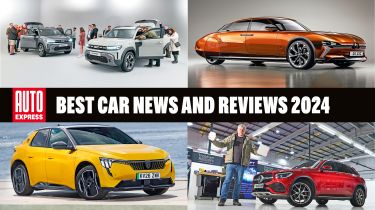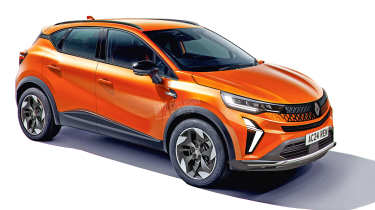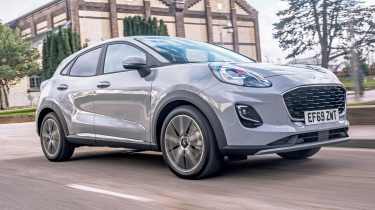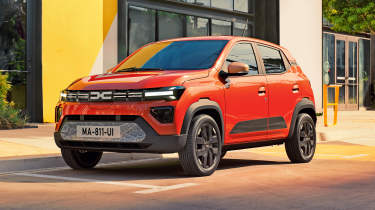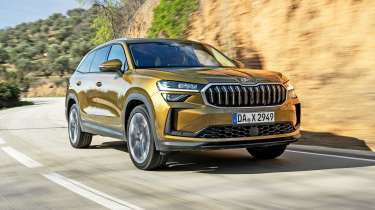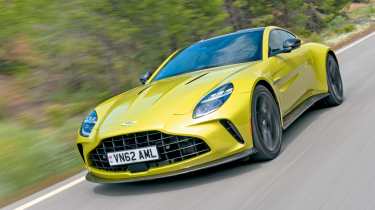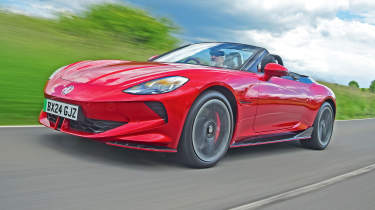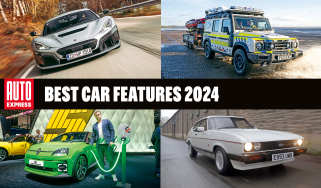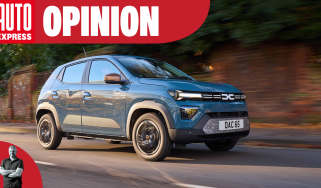Best car news and reviews 2024: your complete guide to what happened, when
We look at the highlights and delights that stood out in a fully packed 2024
With the final advent calendar chocolate nibbled, it’s time to take stock of the past 12 months. It’s been a year packed with exciting news of new models that are soon to arrive and others that we’ve been the first to drive. It’s a wonder we’ve managed to fit it all in, although it is definitely worth the effort.
Every month in 2024, there have been big steps forward in car technology, safety, and security. We’ve witnessed the revival of several classic names in new guises, and this year has also seen the rise and rise of the EV hypercar with ever more sensational performance claims. Yet it is also the year the affordable electric car truly arrived, and we’ve been there to report on all of these events.
Whether you missed a vital story or want to catch up on all the news and reviews that made an impact in 2024, we’ve got the stories here. Enjoy reading it as much as we’ve enjoyed reporting all of it, and let us know in the comments what have been your standout motoring moments of 2024.
January
SEAT reveals plans for baby SUV
We're constantly sniffing around for scoops, and one of our best came when we got wind of a big story surrounding SEAT’s re-entry into the small electric car market.
Things had been very quiet on the SEAT front through 2023, with sister brand Cupra stealing the headlines with its range of sporty, premium-feeling family cars. SEAT had been so silent that we were all but convinced the firm was set to throw in the towel.
But then-new UK boss Marcus Gossen let slip that he had “exciting news coming for SEAT,” which was set to sell cars at least until the end of the decade. “SEAT has to be accessible; it should be the entry level to the group," Gossen told us.
We previewed the results in a set of exclusive images, showing a small electric city car built on the same platform as the forthcoming Volkswagen ID.2, Cupra Raval and Skoda Epiq. The shots, published before the Cupra Raval was confirmed later in the year, showed a baby SEAT with plenty of recognisable styling cues, including sharp creases in the bodywork and a full-width lightbar at the rear.
It’s thought that the city car-sized SEAT will be around 3.7 metres long, with a wheelbase that pushes the wheels right out into the corners. The result is a tall, upright, almost SUV-like stance, with a spacious interior, thanks to the inherent packaging benefits of the new EV-only platform.
Tech details were (and remain) scarce, but we’d assume SEAT will use the VW Group’s economies of scale to make the car competitive. That means a battery pack of around 38kWh and a range of 200 to 250 miles, all for around £17,000. Pricing will be key if its maker wants to maintain its competitive advantage alongside more upmarket rivals.
We also mooted the idea of the car being confirmed at SEAT and Cupra’s annual press conference in March. The news didn’t materialise, but that's most likely due to global boss Wayne Griffiths' comments about he and his team being unable to “electrify” both SEAT and Cupra in tandem. We’ve seen continued momentum from Cupra this year, too, with its older Spanish sibling seemingly forced to wait in the wings.
Gossen has been tasked with boosting SEAT and Cupra’s market share, though, and while the latter is proving more popular right now, it’s clear that nothing is off the table just yet.
Aston’s fresh DB12 shows us its class
Complain all you like about how all Aston Martins look the same – drive old and new back to back and you’ll be in no doubt where the company’s cash is going. Indeed, when DB11 became DB12, we could hardly believe the two were closely related.
We said the Aston is a “very impressive driver’s car, with a huge range of abilities”. But we admitted that while it was beautiful, it wasn’t perfect. It's more supercar than GT, and we asked if the hard-edged ride and sharp handling were what DB12 owners wanted.
Plug-in hybrid tech is star of Golf's facelift
A new Volkswagen Golf could be the cover star of Auto Express every week, such is the public interest in the evergreen car. Yet while variants come and go, it’s not often a facelifted model makes an appearance.
We got our first official look at the Mk8.5 Golf in January, but while the styling upgrades were subtle, under the metal VW introduced a range of plug-in hybrid powertrains with more than 70 miles of electric-only range. These, alongside the interior technical overhaul, made the Golf more appealing than ever.
Renders spot on for Captur and Symbioz
Even infrequent Auto Express readers will know Renault has had a busy year launching a variety of new models. But long before the 4 and 5 were announced, we dug up details on the firm’s next-generation Captur, plus another mysterious small SUV, which later turned out to be the Symbioz.
As usual, we mocked up how we thought the newcomers could look, and the renders proved incredibly accurate. Although the 5 is bathing in the limelight, the Captur (and Symbioz) should prove equally popular, and infinitely more practical.
Puma pounces on top spot in best-seller list
Sometimes the best way to kick off a new year is to look back at the previous 12 months. So, 2023 was a bumper year for car sales, with the greatest number of new vehicles hitting the road since before the pandemic.
The UK’s best-selling car in 2023 was the Ford Puma, followed by the ever-popular Nissan Qashqai and Vauxhall Corsa. Electric cars made up almost one in five new registrations, with the Tesla Model Y getting the largest number of sales. Grey remained the UK’s favourite car colour by far.
Manual no longer automatic choice
Manual or automatic? Most people have historically picked the former, but with the rise of EVs, more are choosing to take their test without the worry of shifting gears. In 2022, 20 per cent of learners took the automatic test, up from two per cent a decade earlier. We caught up with young learners and found they liked an EV's ease, smoothness and green benefits, but some still preferred changing gear themselves.
ID.7 is fine alternative to Tesla's hit Model 3
Volkswagen's all-electric ID brand seems to have had as many hits as it has misses. While the ID.3 and ID.4 were early entrants into the mainstream EV market, core failings meant these models fell short of the class best. The ID. Buzz was much better – as we’ve found out during our time running the German brand’s family MPV on our long-term test fleet.
But it was the ID.7 that surprised us most when we tested it back in January. Designed as a car to take the mantle from the popular Volkswagen Passat, we found the new EV to be a spacious, well equipped and decent-to-drive alternative to the all-conquering Tesla Model 3.
Interior facelift gives Ford Kuga a big boost
Ford made headlines last year when it ditched the big-selling Fiesta supermini to focus on more profitable models, such as its Puma and Kuga SUVs. Both of those cars were treated to mid-life facelifts in 2024 – with the latter revealed to great fanfare back in January.
While the exterior changes were kept to a minimum, an interior overhaul gave the Kuga a new lease of life. Big screens and Ford’s latest SYNC 4 software were welcomed, letting the Kuga compete with the class champs again.
February
Renault finally ends wait for R5
The Renault 5 was arguably the biggest car reveal of 2024, and even as we write this, excitement continues to swell after we finally had a taste of an early production car on UK roads. Don’t expect the hysteria to dwindle next year either, when we start to see the first models trickle through to showrooms and onto school runs up and down the country.
There were few surprises when the covers came off back in February, with the reborn 5 staying true to its concept-car roots and bold colour choices, which is no bad thing in a world filled with black and grey crossovers.
Retro in all the right ways – despite designer Gilles Vidal insisting his team had “not done retro” with the hatchback – but with a modern electric powertrain and offering up to 250 miles of range on a single charge, the Renault 5 is everything we hoped it would be. And we love the French newcomer even more now we’ve driven it.
But let’s quickly recap some of the R5's headline statistics. Sitting on Renault’s new AmpR Small platform, the car measures just 3.92m long and less than two metres wide. Yet within its dinky wheelbase, the manufacturer has squeezed a choice of 40kWh or 52kWh batteries, as well as a front-mounted motor that offers up to 148bhp. Weighing less than 1,500kg, the top-spec version will handle the 0-62mph sprint in less than eight seconds. Top speed is an inconsequential 93mph.
With colourful features aplenty, plus 3D-printed accessories and even a baguette holder for the dashboard, the R5 feels like the right car at the right time. And looking round it we were blown away by the interior quality and big-car features on offer. The Renault 5 is future-proofed with bi-directional charging, twin 10-inch screens and
a family-friendly 326-litre boot; there’s even room for five at a push. This small EV means business; even that brief encounter in a closed studio near Paris sent anticipation levels through the roof.
At a similar time, we were offered an ice drive in the Alpine A290 – the Renault 5’s hotter cousin – as it completed its gruelling cold-weather testing in northern Europe. With even more power, torque vectoring and an ‘OV’ overtake button, we found the brand's little pocket rocket to be stable and controlled, even on the frozen roads of Sweden.
We were left waiting for what felt like months to finally drive the production car, but it was worth every second. Our verdict said it all: “If you’ve been waiting for a small electric car to come along that you actually want to run out and buy, the Renault 5 might just be it.”
We drive Ocean just before Fisker sinks
When we drove the Fisker Ocean in February, the firm’s financial troubles were yet to materialise. At the time, we were presented with a stylish all-electric SUV that offered competitive range, performance and charging figures plus space for the family, and some cutting-edge features.
Little did we know that we’d be almost the only publication to sample the car in the UK; Fisker’s irreparable financial issues set in shortly after the driving embargo lifted – and the rest, as they say, is history.
Iconic Juke takes us back to the future
The original Nissan Juke changed the automotive landscape forever. Building on the success of the Qashqai, the Juke made compact crossovers cool and it sold in huge numbers, despite not being particularly practical, frugal or fun to drive.
As part of our Icon Drives series, we drove an early Juke to see how the market-defining SUV felt more than a decade after it was launched. While modern alternatives run it ragged today, we were surprised at how well the nifty Nissan had stood the test of time.
Expert lifts lid on car thieves' tactics and how to tackle them
With just over one per cent of car thefts resulting in a conviction, many believe car crime has been almost “decriminalised”.
Thatcham Research's Steve Launchbury showed us how crooks use tech to steal cars, such as relays to mimic keyfobs, jammers that stop the use of trackers, and controller area network (CAN) kit that can plug into wiring harnesses and unlock doors, or even start a car. The expert advice? Install an alarm and a tracker, plus use passive devices such as a steering lock to help ensure you don’t become another statistic.
MG3 packs punch and practicality
MG is on a roll. It has captured the minds of UK buyers after affordable small cars and SUVs that do what they say on the tin – but with a new-found dose of style and sophistication thrown in for good measure.
The MG3 wowed us when it was revealed, and has since become one of our favourite cars of 2024. Its punchy hybrid powertrain, slick tech and practical cabin combine to make it a shrewd-yet-stylish supermini that can give the best a serious run for their money.
McLaren lifts the lid on its Artura Spider
Despite McLaren launching its first hybrid hypercar more than a decade ago, it’s since slowed down its embrace of electrification. Yet earlier this year it lifted the lid on its first plug-in drop-top: the Artura Spider.
At the time the maker said performance was “almost indistinguishable” from the equivalent coupé; 0-62mph takes just 3.0 seconds, and it’ll hit 205mph flat out. It uses the same carbon tub as the coupé, but weighs just 62kg more, most of which comes from the new retractable hard-top.
Electric Spring breezes in
For less than half the price of the Jeep, Kia or VW, you can now buy a Dacia Spring: a dinky, city-focused electric car with a 26.8kWh battery, up to 130 miles of range and DC fast charging. It clearly piqued interest when it was revealed back in February – our cover story titled ‘Dacia’s £16k EV’ was one of our biggest-selling issues of the year.
The Spring has been sold in Europe for a few years now, but the original was never offered in the UK. Yet with appetite for affordable EVs seemingly on the up, the Mk2 feels perfectly positioned to take the market by storm.
There are a couple of motors and two trim levels to choose from; the higher-spec model has features like a 10-inch infotainment system and sat-nav, 15-inch wheels and electric rear windows. The Spring even supports vehicle-to-load charging tech, so you can power external devices, such as a cool box or laptop, or even your home in the event of a power cut.
The diminutive Spring should be pretty practical, too. There’s room for four inside, thanks to its tall roofline and wide-opening rear doors, while behind the seats is 308 litres of boot space. Fold them down and that area expands to more than 1,000 litres – handy if you occasionally need to carry big or bulky loads.
When the electric city car was revealed, we caught up with design director David Durand who talked us around the Spring and showed us what his team had done to keep things simple and limit the chance of inflating costs. One example he gave was the graphics on the C-pillar; by using a sticker instead of a stamping it saved money – contributing to that super-low list price and making the Spring the most affordable new EV you can buy.
SEAT marks Ibiza’s 40th anniversary
SEAT invited us to celebrate its Ibiza supermini’s 40th birthday. Where, we hear you ask? Bafflingly, not an island in the Mediterranean Sea famous for its nightlife. Instead we headed to the firm’s factory in Barcelona to drive all five generations of Ibiza.
While we wait for SEAT to release its first production EV, we were surprised to discover the one-off prototype Ibiza Electrico from the early nineties, showing the firm has harboured a desire to go electric for a long while.
Countryman adds space to MINI fun
Can we just stop the “it’s not very mini” heckles from the back, please? No, the new MINI Countryman isn’t particularly small, but when we drove the hot JCW version for the first time earlier this year, it was plain to see that it still had plenty of inherent MINI character buried within.
Fast, fun and loaded with “cheekiness”, the JCW isn’t our pick of the range, but we enjoyed our early spin near Lisbon, Portugal. If you love what a MINI says about you but need a bit more space, the Countryman could be the car for you.
March
Revised A3 heralds Audi car blitz
Back in March, Audi showed off its revamped A3 hatchback and saloon, plus their hot S3 variants. The refresh aimed to address criticisms of the Mk4 model, with changes including higher-quality interior materials and a touch more glamour with new LED lighting plus a cleaner, more expressive exterior design.
But even then we knew this was just the start of some big moves from Audi, thanks to a major model blitz due from 2024 onwards. There are generally two branches of Audi’s range-wide revolution, and our reporting laid down the groundwork of how this would look over the forthcoming 24 months.
The first would be electric, starting with two all-new Q6 and A6 e-tron models. These are based on a brand-new PPE platform developed between Audi and Porsche, offering cutting-edge electric powertrain tech, big batteries and impressive estimated range figures. Since then, we’ve also seen these expand into second bodystyles for both plus high-performance S models, too.
But it was arguably the internal-combustion cars that were going to have more impact, with the A5 and Q5 shown off via our exclusive renders. While they could have been seen as less ambitious back at the start of 2024, the changing sentiment towards pure EVs – especially expensive ones – means that Audi might just be onto a winning strategy by introducing these two petrol, hybrid and diesel models when everyone else is thinking about removing internal-combustion models from sale.
We also reported on three more new petrol-powered models that we won’t see until 2025. These included a new Q3 and an all-new Q7 that will replace the current model that’s been on sale for nearly 10 years. But it was the final model that will likely be the biggest shock. Audi’s pure-electric A6 e-tron will pave the way for a wider, petrol-powered A7 range, offering a similar hatchback bodystyle to the current model, but adding in a new Avant model.
BMW’s Neue Klasse X previews the future
BMW’s Neue Klasse concept from 2023 certainly created a stir when it was revealed, but as can often be the case with early design concepts, its relevance to a production model could be seen as ‘vague’.
Well, March saw the debut of BMW’s latest Neue Klasse X concept, a car that gave us a much clearer picture of what to expect when the next-generation production models hit the road from 2025. Previewing a new mid-size all-electric SUV, this is pretty much what we’ll be seeing on the roads, funky interior included.
Chinese EVs behind insurance cost rises
Car insurance prices have long been on the rise; premiums went up by 50 per cent in 2022, then another 25 per cent in 2023. But why? The Association of British Insurers blames “increasing costs of repair, materials [and] labour”, but another key issue is the influx of EVs, particularly from China.
Several models across a handful of makers have been deemed uninsurable due to the lack of parts and technical support in the UK. A shortage of repair shops with knowledge of electric cars only exacerbates the issue.
Yangwang’s £120,000 U8 luxury SUV makes a big first impression in UK
March was also the month that we got one of our first experiences with a truly high-end Chinese car. The massive, £120,000 Yangwang U8 – the flagship SUV model from BYD’s luxury sub-brand – showed its stuff to the media at a day out in Goodwood.
The electric leviathan packs around 1,200bhp, but rather than a running a combustion or plug-in hybrid powertrain, it has an EV set-up with a small petrol range-extender – something that’s becoming popular in China, and might well catch on in other markets, too.
Revamped hybrid set-up tops Juke’s 2024 refresh
March also saw us drive a revamped version of one of the UK’s most popular models, the Nissan Juke. This small B-segment SUV has long been a massive seller for the Japanese manufacturer, despite its quirky design and compromised interior space. What it did offer, though, was largely efficient and reliable motoring, with a hint of flair.
This mildly updated Mk2 Juke looks similar, but brings some worthwhile updates. These include a redesigned dashboard with a larger and higher-quality infotainment display, plus a new digital instrument cluster, contrasting coloured elements on the dash front and some funky colour and trim options.
But the biggest upgrade is the car’s improved hybrid powertrain. This combines a 1.6-litre four-cylinder engine with an electric motor and compact battery pack to yield appreciable gains in efficiency without sacrificing performance or driveability. On paper, the Juke is capable of up to 58.9mpg, while only just missing out on breaking the 10-second 0-62mph barrier.
While this all sounds like a solid win for buyers, we did find that some of the hybrid powertrain’s elements aren’t quite so polished, such as the automatic transmission that didn’t seem capable of keeping up with the model’s impressive new engine. In essence, this powertrain technology is the same sort that’s found in recent Renault products, and while it’s efficient, it doesn’t work quite as well as transmissions found in comparable rivals with a CVT or even a dual-clutch set-up.
The Nissan’s overall driving experience also left something to be desired, because despite the sporty look, we found the Juke to be a little lumpy on the road. The stiff ride and lifeless steering do nothing to improve the enjoyment from behind the wheel.
So when combined with the typically limited interior space, the latest Juke still can’t quite compete with the best in its admittedly crowded class. The newcomer does, however, still look the part and offer solid value for money.
All-new Skoda Superb lives up to name again
There are groundbreaking new models, forward-thinking tech, disruptive design, but the Skoda Superb is none of that, and for the people who buy and love them that’s no bad thing.
The all-new large hatchback and estate’s petrol and diesel engines might seem old-fashioned, but as we found out on the global launch, it does an awful lot of what drivers are asking for efficiently and cost effectively. Without compromising on all the elements that make a Superb, err, superb, the new car is cleaner, sharper to drive, more tech-friendly and even a little more posh.
Panda family breaks cover
Spite is not something we often see in the car world, but Fiat’s decision to launch an entire family of Panda concepts the day before the renewed 2024 Geneva Motor Show, while not actually attending, was a particular highlight in March.
Fun and games aside, Fiat’s family of new Pandas preceded the production car’s reboot by a few months, but also said more about the brand’s ambition to return to being a staple of European top-10 sales charts.
This much can be seen in the sheer aspiration of the five models that were shown. First was the precursor to the production Grande Panda we’ll be driving next year. But the others were more ambitious, and should also make it into production over the next few years.
One was an SUV concept that introduced an even blockier and more upright stance than the Grande Panda. This could make it a key seller for the brand and return Fiat to its historic homeland of building clever, frill-free family cars that are capable and rugged, but also easy to drive and cleverly designed.
Next was the Fastback concept that took the SUV’s utilitarian foundations and gave it a more stylised flare as a reimagination of the traditional C-segment hatchback.
There was also a pick-up truck that’s unlikely to be offered in the UK, as well as a cab-front MPV-like model that will be channeling Fiat’s old Multipla just as hard as it is the Panda.
The element that will likely bind all of these models together beyond just being called a Panda is the Smart Car platform that has already been so successful in transforming the lower end of the Vauxhall and Citroen ranges.
MG working on low-cost electric 2
We also delivered one of the biggest scoops of the month by revealing that MG is on track to introduce a new supermini-sized EV called the MG2.
This new model is poised to enter the low-cost EV segment with a price of around £17,000, undercutting competitors such as the Citroen e-C3 and Fiat Grande Panda. It’s due to arrive in the second half of 2025, and MG is confident that the 2 will be the right product at the right price.
April
New Frontera arrives
Another reborn nameplate was introduced, this time in April, taking the form of a new Vauxhall Frontera. As we reported in our Top Story, the new car might not share anything obvious beyond a name with the previous body-on-frame 4x4, but there’s actually rather more of a connection between the two than meets the eye.
You see, back in the eighties and nineties, Vauxhall’s then owner, General Motors, was happy to sell different models from different markets when fitted with an appropriate badge. As a result, the Vauxhall Frontera’s Japanese origins made it an ideal, tough off-roading model for the time.
The difference now is that rather than a simple re-badge, this new Frontera has been built on the bare bones of the Smart Car platform developed by Vauxhall’s parent company Stellantis. This platform is inexpensive to produce, but also flexible enough to be stretched across the B and C segments, while supporting hybrid and all-electric powertrains.
Although the Frontera successfully adopts Vauxhall’s distinctive ‘Vizor’ front end, from there back it shares a body-in-white with the upcoming Citroen C3 Aircross. Vauxhall did lots of work to disguise the shared elements, and thanks to a new rear-end design, fresh wheels and a completely bespoke interior, most won’t see the connection beyond the two sharing the same gear selector.
But what the design doesn’t reflect is how clever Vauxhall has been in leveraging the Stellantis group to create such a compelling overall package. This relatively low-cost chassis has kept the price down, while offering an interior that’s bigger than the more expensive Mokka’s. It also does this with both three-cylinder hybrid and fully electric powertrain options, with no price premium for the EV.
That really is the point of this car, because it brings practical and efficient motoring to a new audience. The Smart Car platform and its embedded tech might not be groundbreaking, but the price point that Vauxhall is able to sell the model at is. That’s why we thought the Frontera is so important, not just for the firm, but also buyers who want to go green, but can’t stretch to or justify the higher prices often associated with practical electric cars.
Seven-seater option sets C3 family apart
Alongside the Frontera, Citroen used the month of April to reveal two takes on the Stellantis Smart Car Platform.
Unveiled within weeks of one another, the Citroen C3 and C3 Aircross were introduced with a similar combination of all-electric or hybrid powertrains, chunky styling and affordable entry-level prices.
Despite looking similar, the two cars feature one key difference: the C3 Aircross will be offered with space for all the family, potentially making this the cheapest seven-seat electric vehicle on the market.
A stalwart of the Auto Express twin test is the classic supermini showdown, and in April we brought together a Toyota Yaris and the then recently refreshed Renault Clio.
Things aren’t as simple as they once were, and little four-cylinder engines and five-speed manuals aren’t on the agenda today – now efficient hybrid powertrains and clever automatic gearboxes are all the rage. Despite not having Toyota’s history with hybrid power, Renault won with its lower price, more spacious rear seats and bigger boot.
Porsche hits the nail on the head with all-electric Macan
The new Porsche Macan was also under its first proper round of scrutiny in April, with Auto Express heading out
to France to drive the manufacturer’s critical all-electric SUV.
But this Macan doesn’t just replace a wildly successful petrol-powered predecessor, it does so on an all-new platform that’s been co-developed with Audi. Did it pay off? We found the latest Macan to be a brilliant realisation of Porsche’s best bits integrated into a good-looking and reasonably efficient family SUV.
Super-smooth Rolls EV tackles British roads
April was also when we got behind the wheel of the world’s most opulent EV, the Rolls-Royce Spectre, in the UK, where its final reckoning would be our potted roads.
Despite the massive set of wheels it was running, and its colossal kerb weight, the Spectre still shone thanks to its bank-vault quality and sheer depth of engineering. In fact, John McIlroy, who was also lucky enough to experience the car at its international launch in South Africa, said that it was still in a class of one, and absolutely lived up to the Rolls-Royce image.
New Kodiaq picks up where the Mk1 left off
Some cars are almost impossible to beat – right into their twilight years. The Skoda Kodiaq was one of those cars, so when a new one came along late last year, anticipation was high.
When we drove it in April, any concern that it’d fail to live up to its predecessor’s prowess instantly faded away. The Kodiaq remains a fantastically adept family car; our verdict suggested practicality and refinement had been “honed to near perfection”. The Skoda was crowned Best Large SUV at the 2024 Auto Express New Car Awards.
Wraps come off first Alfa EV
Only in Italy could a brand launch a car, only to be told moments later that its name wasn’t allowed under federal law. The Alfa Romeo Junior (nee Milano) was a highlight for April, and not just because of the badging debacle. The car also represents a new beginning for Alfa Romeo.
This compact, all-electric or hybrid SUV is built on the same e-CMP platform as many Stellantis products, from the Fiat 600e to the Jeep Avenger. The company hopes it will make more of an impact than the larger Tonale, and on first sight it definitely did.
Alfa launched the Junior with a 54kWh battery pack and a single electric motor mounted on the front axle with 154bhp. Entry-level Elettrica cars have a 255-mile range, and there’s also a hybrid option available, but the model that made headlines was the flagship Veloce edition. This was launched with 238bhp and a 208-mile range, but ‘found’ an extra 40bhp a few months after its unveiling. This model also introduced a range of chassis upgrades including a limited-slip front differential, 20-inch wheels and larger brakes.
The cabin was also the recipient of some high-class upgrades, including some very fetching bucket seats, plus an aggressive and sporty overall combination of Alcantara, red stitching and lots of funky design elements such as illuminated air vents and an optional part-Alcantara steering wheel.
Alfa Romeo hoped that this combination of changes would finally put some fire into a platform that’s only so far really produced rather benign offerings. Happily, a drive in the car later in the year showed they had managed just that.
Nissan’s EV range in line for growth
An ambitious new strategy was announced by Nissan, who confirmed five new EVs would arrive by 2026. These
will include a new Micra based on the same platform as the Renault 5, plus a brand-new Leaf that’ll shrug off its lumpy hatchback body for something much more stylish.
Most ambitious of all will be electrified updates of the Juke and Qashqai – the former due first, and the latter in 2026 – plus an all-electric version of its Interstar van.
EU reveals shortfall in official economy tests
Ever wondered why it can sometimes be difficult to get close to your car’s official fuel economy rating? A study by the European Commission found that, on average, petrol cars typically fall 24 per cent shy of their official WLTP fuel economy and emissions ratings, while diesels are 18 per cent behind.
A new test for plug-in hybrids is coming in 2026 because, due to the method in which they are currently tested, they are typically three-and-a-half times more polluting in everyday use than the official stats might suggest.
Aceman arrives to plug gap in the MINI range
MINI launched a brand-new model this year that will sit neatly between the Cooper hatchback and Countryman SUV in its line-up. The new all-electric Aceman is a five-door crossover that blurs the line between hatchback and SUV, featuring all the usual MINI design elements in a funky new package.
It essentially takes the place of the five-door MINI Cooper, which is still available in petrol form, but not as an EV. We were so impressed that we named it our star of the 2024 Beijing Motor Show.
May
Skoda Octavia gets better with age
May saw us get reacquainted with our 2020 Car of the Year, the Skoda Octavia. With a new look for 2024, plus more kit as standard, things were looking good for the Czech hatchback. The estate's boot also impressed, as it has in every Octavia edition, now with an incredible 640-litre capacity.
While the hatchback we drove was the entry-level spec, the estate was a more lavishly equipped SportLine and featured a diesel engine – something we felt really suited the long-legged ability of the Skoda.
Kia EV3 impresses with range and looks
Kia is developing a habit of bringing concept cars to life with few tweaks, and the Kia EV3 production car unveiled in May certainly continued this trend.
Sitting alongside the similar-sized Niro EV, the EV3 beats its sibling in every key area and wears the design language Kia reserves for its EV line-up extremely well. ‘Star-map’ daytime running lights at the front, chunky wheelarches, a sloping roof and defined bodywork ridges all help it look like a mini EV9.
The EV3 is not all style and no substance, however. It sits on Kia’s E-GMP architecture which underpins the EV6 and EV9 and uses either a 58.3kWh or 81.4kWh battery. A range of 254 miles can be expected out of the smaller battery, while the big unit gives a 372-mile range – almost 100 miles more than the Niro EV. Pricing was revealed later on in the year with a £32,995 entry point – more than £4,000 cheaper than its sibling.
There’s a huge amount of space up front and in the rear, with a two-tone, light and dark colour combination adding to the natural light of the cabin. A 460-litre boot is remarkable for a car this size and there's even a 25-litre storage box under the bonnet. It might be a new model, but easy-to-use controls are carried over and, while twin 12.3-inch screens look good, the central 5.3-inch display for the climate is obscured by the steering wheel. One thing that stands out are the headrests, a strange thing to highlight perhaps, but the simplistic ingenuity of using a thin mesh here impresses.
We couldn’t wait to drive it in the UK so we went to Korea for an early taste, learning that even the entry-level EV3 steered, stopped and went as well as we’d hoped.
Aston Martin Vantage gives the British brand a credible 911 rival
We were treated to not only a new Vanquish in 2024, but also a new Vantage. Aston Martin set to work improving plenty of key areas of its Porsche 911 rival, with better interior quality and a far superior touchscreen infotainment system.
What’s more, the Vantage kept its AMG-sourced twin-turbo V8, gaining an extra 153bhp and 116Nm of torque – taking its output to 656bhp and 800Nm. The revised eight-speed gearbox gave greater flexibility and the ride was much improved despite razor-sharp handling.
MINI Cooper maintains winning formula
Bringing plenty of colour to the cover of Issue 1,830 was our first drive of the all-new MINI Cooper. A real icon of the automotive world, a new MINI – especially a three-door and one designed purely for all-electric power (the new petrol-powered one has a different platform), is always big news. We’d seen it testing multiple times and even caught it undisguised in a Los Angeles advertisement video shoot, so our intrigue was huge by this point.
We had high expectations of the new MINI before we got our first taste of the production car and happily, it didn’t disappoint. We found only a few minor negatives on the new car, namely the Cooper SE's lofty £34,500 price tag. There was also the packaging of the battery, which resulted in tight rear legroom and the boot capacity – a running joke in MINIs, only provided a meagre 210 litres of storage.
All of the positive things we’d expect of the MINI were thankfully retained for this new EV, however. Our car had the larger 49.2kWh battery, which was good for around 250 miles of range. There’s a vibrant interior with lots of stand-out features like the fabric spoke on the steering wheel and a big, circular infotainment screen taken from the new Countryman. The clear graphics on the touchscreen, along with the speed at which it could navigate various menus, was also impressive. As we’ve come to expect, the MINI oozed quality inside, too.
Most importantly, the new car drove like a MINI. Our SE had plenty of poke with 215bhp and 330Nm of torque, so straight-line performance was never an issue, despite the portly 1,700kg kerbweight. The MINI also felt agile enough to align itself with the engineer’s ‘go-kart’ claims; steering was direct and the pedals progressive. A trade-off for the MINI’s compliance in the bends was a slightly firm ride – something we later found on the MINI Cooper E model, too.
Ferrari 12Cilindri nods to tradition
The covers came off the brand-new Ferrari 12Cilindri this year as a replacement for the 812. It continues Ferrari’s flagship GT tradition of having a huge 12-cylinder engine and RWD, with 818bhp, 678Nm of torque and an astonishing red line of 9,500rpm.
The figures match those of the old 812 Competizione, with the help of turbos or electric motors. The styling paid homage to the classic Daytona in many ways.
We predict DS's new concept car ahead of its autumn reveal
Back in May, Auto Express caught wind of something special in the works at DS – a new French flagship. Speaking exclusively, DS boss Olivier François said that a new car inspired by the legendary Citroen DS of the sixties could be on the way.
Being an all-electric car, aero-efficiency was as much a priority as the looks. François told us: “If we can tie back to this design DNA, we can have the best-looking and, more importantly, the most meaningful aero-designed electric car in a world of new brands, where we are ourselves a new brand. The pure DS should be large, expensive, and amazing.”
This set our imaginations racing – what would a modern DS 19 look like with electric power? We came up with the answer in Issue 1,831. Rounded panels, a sleek body, a floating roofline and split-opening doors were all chosen, as was the rear wheel cover to promote efficiency, but also act as a tribute
to the icon with its hidden rear wheels.
With DS positioned as a luxury brand within the Stellantis portfolio, it has to compete with the likes of BMW, Mercedes, Audi, Volvo and newer pure-electric brands such as Tesla and Polestar. In order to do this the car must show the best of the company’s technology.
Luckily, François also let slip some technical details that we could expect from DS’s flagship – an impressive 435-mile range and 800-volt architecture that will allow 10-80 per cent top-ups in less than 20 minutes.
The fact the DS 19’s debut would celebrate its 70th anniversary in 2025 all but sealed the legend's return. The car was later revealed as a concept in September as the DS SM Tribute.
Graduated licences bill proposed
The controversial topic of graduated licences was thrust into conversation as a new bill was put forward, proposing that for the first six months, newly qualified drivers would be prevented from carrying passengers of a similar age and restricted from driving at certain times.
The Motor Vehicles Driving Licences (New Drivers) Bill also proposed a zero limit on alcohol, with the Transport Select Committee saying such it would reduce crash rates.
New G-Class fuses heritage and tech
The G-Class is an icon of Mercedes history, transcending utilitarian roots to become a fashion accessory for the social elite.
We got behind the wheel of the revamped AMG-fettled G 63 in May alongside the G 580 EQ Technology to see if the new ‘G’ was better with petrol or electric power. Even with its new looks and fresh mild-hybrid powertrain the G 63 was as wonderfully ridiculous as before – the G 580 with its pure-electric powertrain, proved it retained some classic G-Class traits
June
New 1 series no longer sees eye to i
BMW has been using ‘i’ to designate its petrol models for so long that when the fresh 1 Series dropped it earlier this year, we were a bit taken aback. That’s before we got around to the rest of the car, which has changed so much over its predecessor that BMW even gave it a new model codename (F70 replacing the old F40), despite it using the same platform as before.
Styling cues on modern BMWs are a contentious and divisive topic. The new 1 Series features a slightly tweaked rear and a ‘1’ emblem on the rear pillar, but the big changes are at the front with the new grille. It's possible to make the kidney grille look like a single unit, and it incorporates some horizontal and diagonal bars within. The revised front is complemented by a new headlights and a reshaped bumper – significantly different enough that BMW actually asked Euro NCAP to test the 1 Series again for this new version.
More tweaks appear on the inside, the biggest being a new dual-screen set-up. This is a curved unit made up of a 10.7-inch touchscreen and a 10.25-inch driver’s display, running BMW’s latest OS9 infotainment, at the cost of the iDrive rotary controller on the centre console.
At the same time, the diesel option was axed from the 1 Series range; BMW launched the fresh line-up with a base 120 featuring a new mild-hybrid 1.5-litre three-cylinder and a 296bhp 2.0-litre four-cylinder for the Audi S3-rivalling M135. The hot hatch gained a quad-exit exhaust system, which was previously something reserved for BMW's M division models, thus quelling our hope of a 1M or new M140 in the process.
Power was also down on the old 302bhp M135i, but BMW said we could expect more fun than before. That rang true when it beat the recently updated Audi S3 in a premium hot hatch shootout later in the year, thanks to its standard-fit adaptive dampers and engaging chassis.
Bugatti stuns with Tourbillon
The 1990s had the EB110, the 2000s the Veyron, and the 2010s saw the Chiron. For the 2020s then, Bugatti had to pull out all the stops – and it did so by unveiling the Tourbillon.
Putting aside the incredible looks (clearly inspired in some places by its Veyron and Chiron predecessors), the Tourbillon, as you’d expect from a Bugatti, possessed a raft of top-trump statistics. A naturally aspirated 8.3-litre V16 combined with three electric motors for 1,774bhp and a targeted top speed of 275mph. Shifting with the times, Bugatti’s new hypercar even features 37 miles of EV range.
MG goes back to its roots with Cyberster EV
From sketches to digital renders, we waited years to get behind the wheel of MG’s new Cyberster in the UK, finally getting the chance this summer.
The all-electric convertible genre is a bit of a niche right now, so the Cyberster delivered a fascinating driving experience. We found the lack of noise unusual in a car that is so ferociously quick in a straight line. While the ride was smooth enough when cruising, MG failed to hide the Cyberster’s 2.2-tonne kerbweight in the bends.
Readers’ demands help us draw up our own motoring manifesto
Ahead of the 2024 General Election, Auto Express revealed its own motoring manifesto. We listened to your biggest concerns and pushed for greater clarity on the 2030 ICE ban, better policing of our roads, and fairer fuel pricing. Some items, such as requesting a solution to the pothole problem, are beginning to be implemented by the new Labour administration. Chancellor Rachel Reeves has announced an extra £500m for road maintenance in 2026.
Tesla takes fight to BMW with revised Model 3 Performance
A BMW M3 killer for less than £60k? That’s what Tesla wanted us to believe about the first Model 3 Performance. It lived up to its name in a straight line, but was a little disappointing in the bends.
Roll up the updated 2024 version. With a zero to 62mph time of around three seconds, it had the punch, and chassis tweaks made it feel much better through the corners. While it doesn’t have the M3’s engagement levels, it shows what great strides the Model 3 has made.
Top cars and brands named
Every year you nominate the best cars to own as part of our Driver Power owner satisfaction survey. This year saw the previous-generation Dacia Duster end up in top spot; buyers loved the sheer value for money it offers, as well as how simple its controls are to operate – something that’s becoming increasingly rare nowadays.
Second-best was the safe and smooth-driving Tesla Model 3, with its massive 14-inch touchscreen helping it secure a third-place ranking in the information tech category. Rounding off the podium spots was the frugal Toyota Yaris hybrid, which impressed owners with both its reliability and build quality.
Those two qualities also secured Subaru its place as your favourite car maker of 2024. The Japanese marque may have somewhat faded into obscurity nowadays, but owners still told us they appreciate their cars’ practicality, boot space, comfort and value for money.
Tesla clinched an impressive second-place ranking in our brand survey, with buyers enjoying cheap servicing and charging costs, plus brisk acceleration and cutting-edge technology. Elon Musk’s EV brand is yet to shake its reputation for poor build quality, though, with Tesla ranking low in this regard.
Finally, the bronze brand medal went to Kia, which isn’t surprising given that it only ranked outside the top 10 for a single category: powertrains. Owners love their cars’ slick infotainment and strong sense of value. Striking exterior designs, well built and ergonomic interiors, and big boots also get the thumbs up.
Latest BMW X3 flies the flag for ICE power
A global sales hit, the X3 is a hugely important car for BMW, and in 2024 we saw the all-new fourth-generation model arrive. An all-electric iX3 version previewed by the Neue Klasse X concept will arrive in 2025, so the latest X3 can focus on internal-combustion engines.
There are diesel, petrol and plug-in hybrid powertrains to choose from, so alongside the next iX3, BMW’s mid-size SUV really should have something to suit all tastes. But the new X3’s styling is certainly bold, with lots of inspiration taken from BMW’s controversial iX and XM.
Nissan’s turning over a new Leaf
The Nissan Leaf was a real pioneer of the EV world, but as a testament to the ever-evolving industry, the latest one is far from the best electric car you can buy.
But Nissan confirmed to Auto Express that the funky-looking Chill-Out crossover concept will inspire the next Leaf. Bringing the third-generation model bang up to date will be the new AmpR platform that’s been developed along with Renault, allowing for around 280 miles of range on a charge.
EU and US slap tariffs on Chinese EV imports
Alleged “unfair subsidisation” by Beijing led to the EU placing tariffs of as much as 48 per cent on EVs imported from China.
Some brands, such as Tesla, were granted special consideration and are thus not as heavily impacted. But ultimately the new taxes, which were designed to level the playing field for European firms, will inevitably push up prices for consumers. The US followed suit with 100 per cent tariffs on Chinese EVs. So far, these moves haven’t been echoed by the UK.
It's been an action-packed year! Now take a look at page 2 of our 2024 news and reviews highlights...
Find a car with the experts
